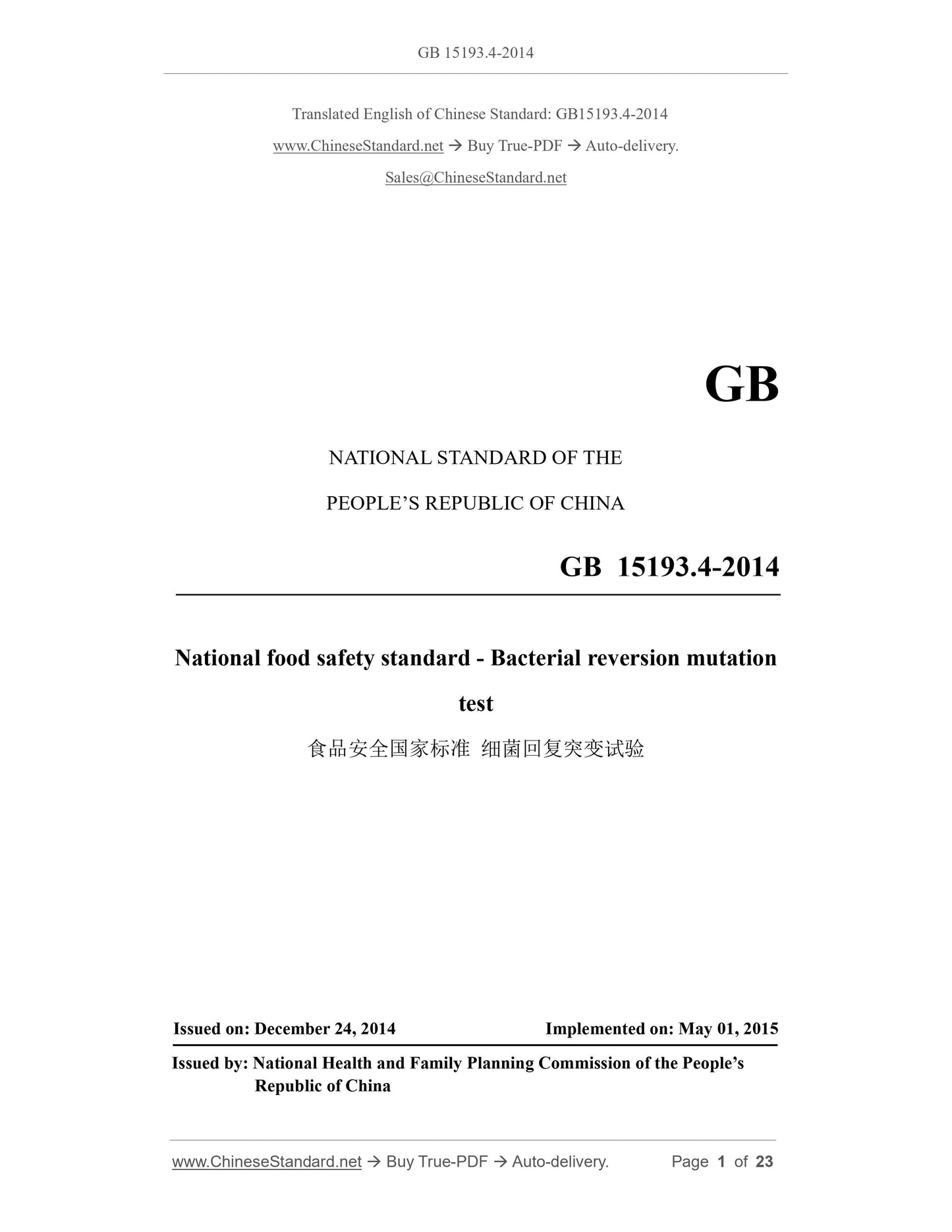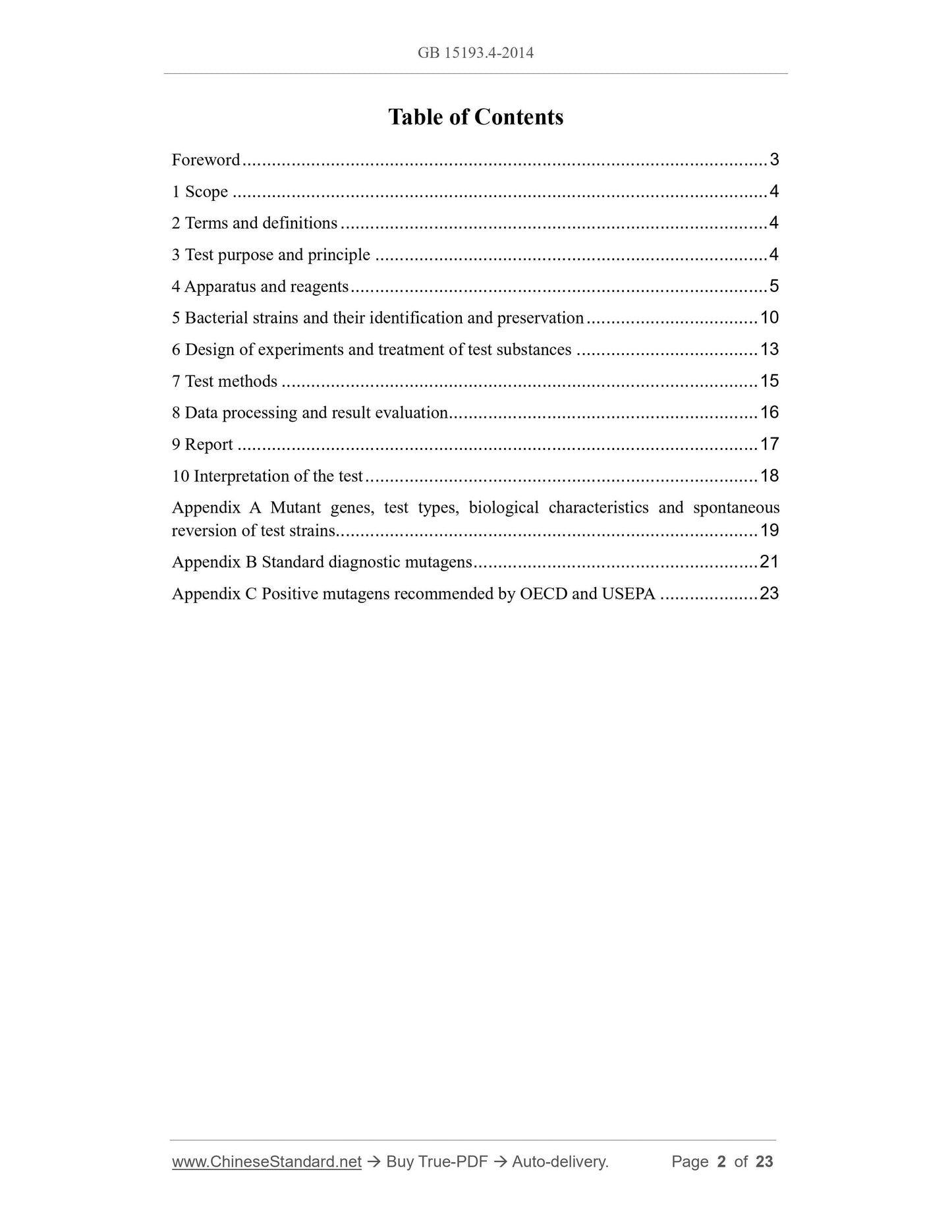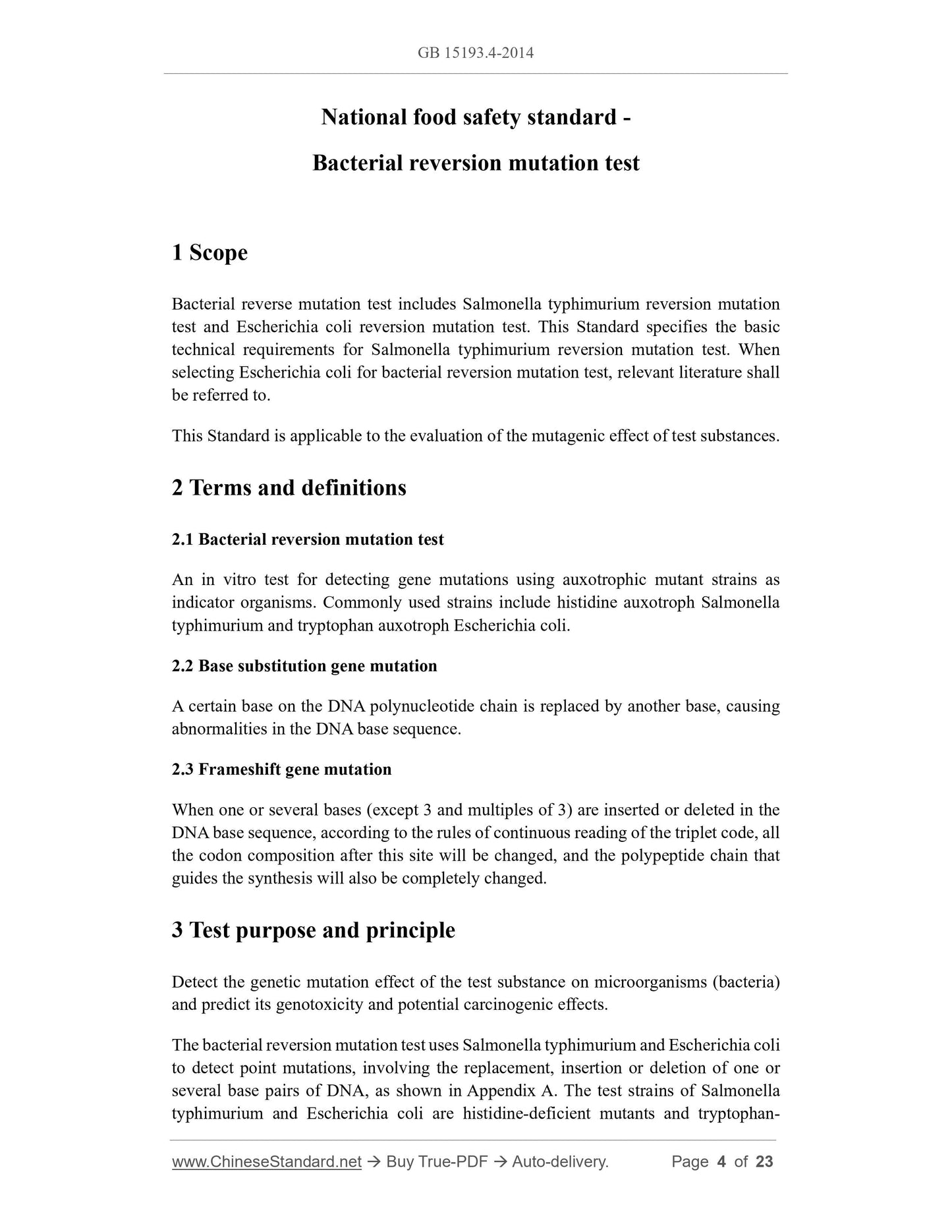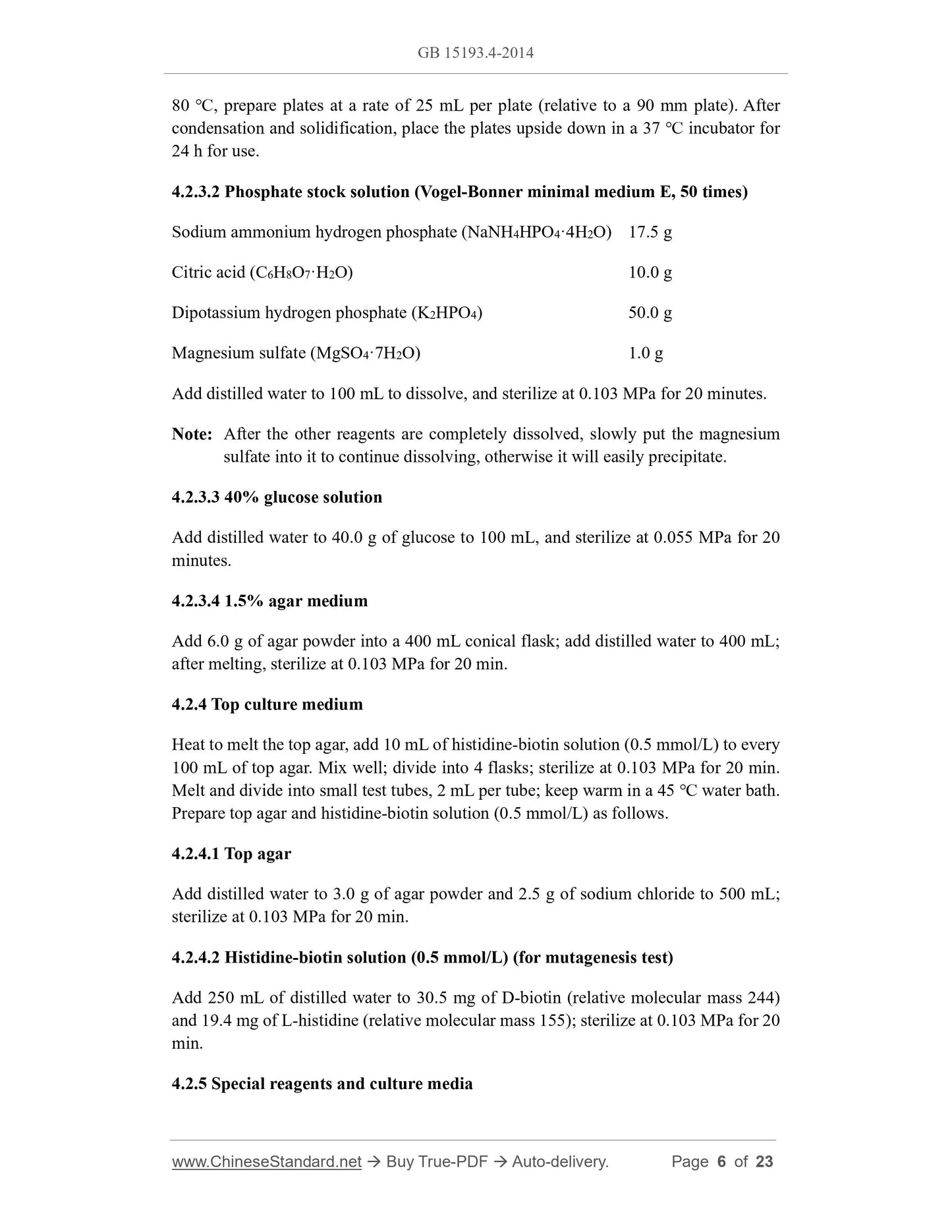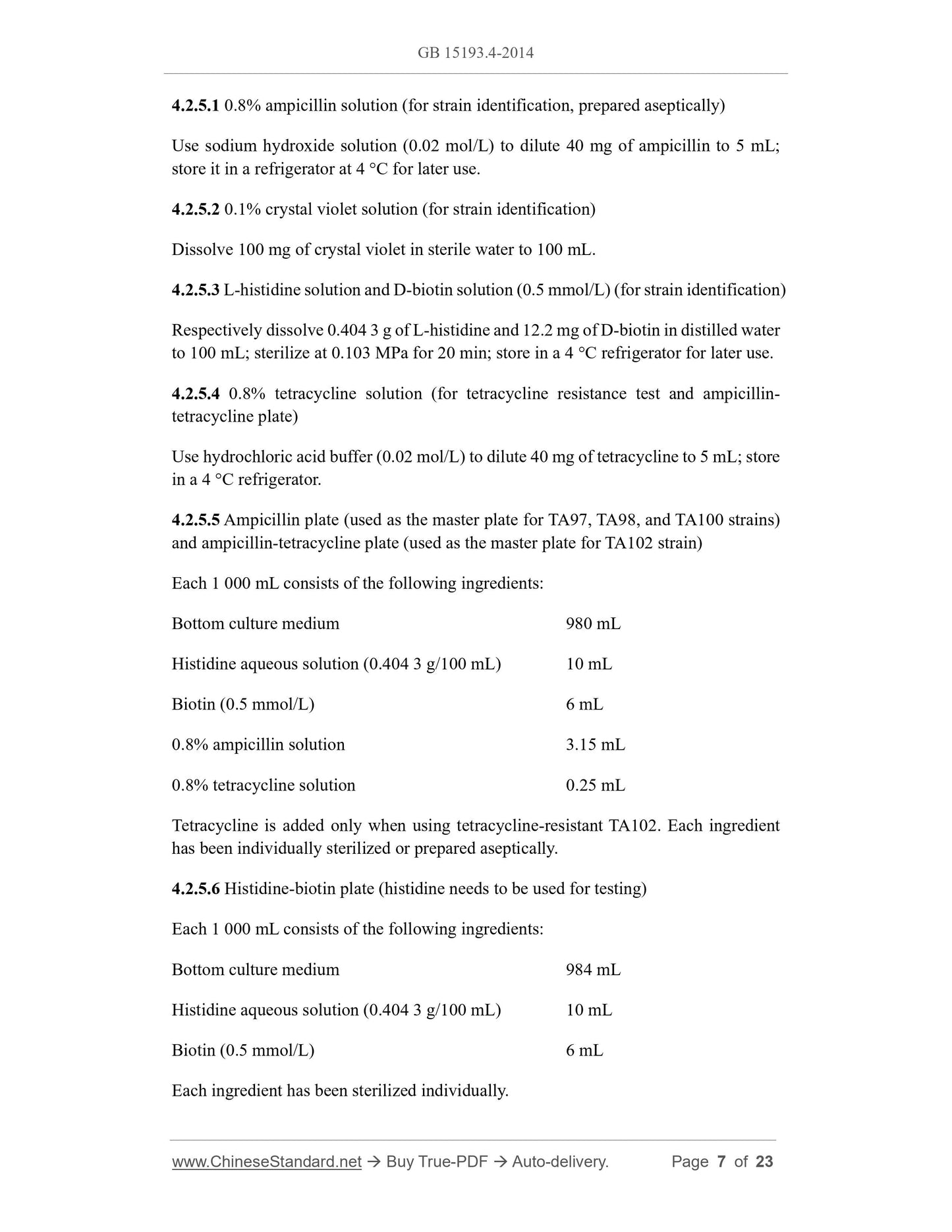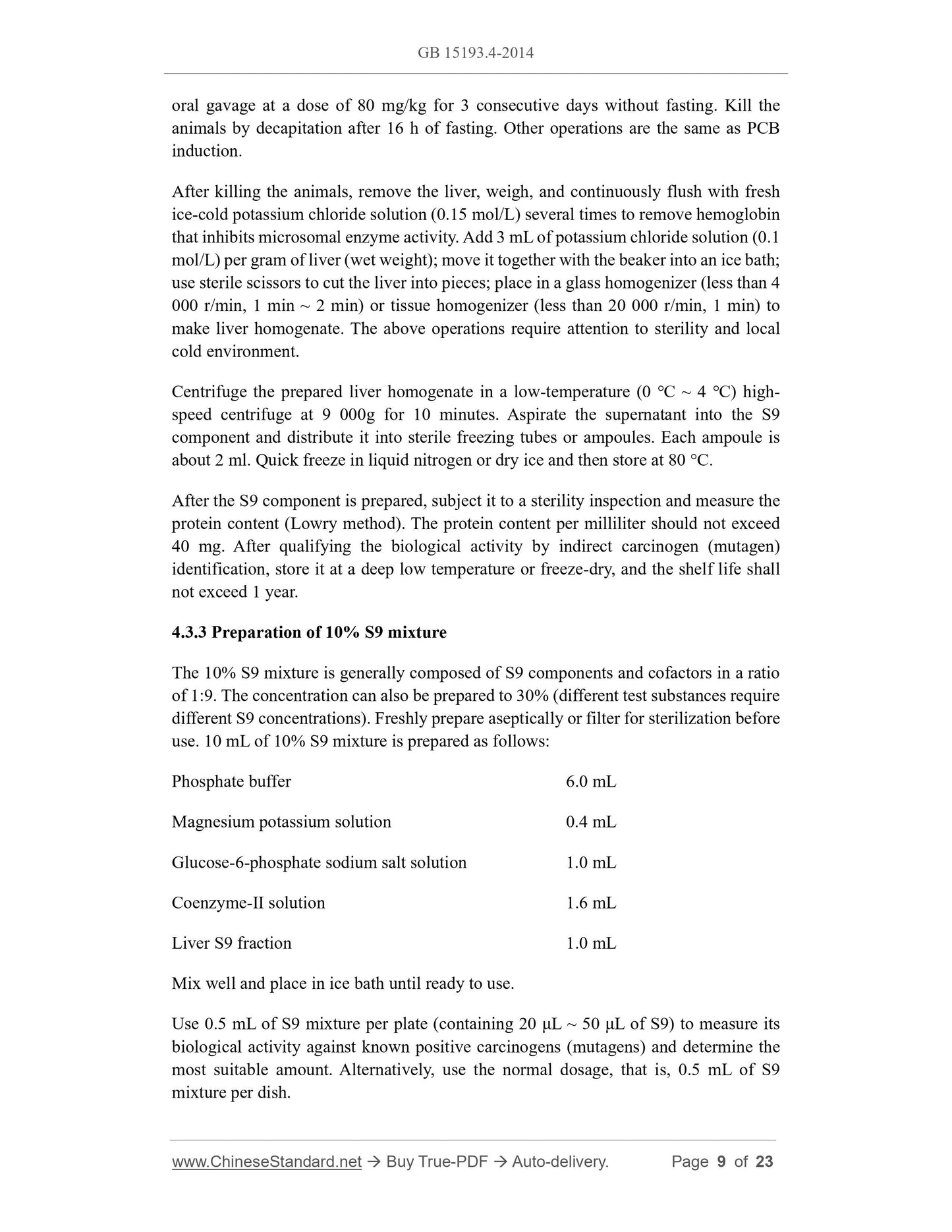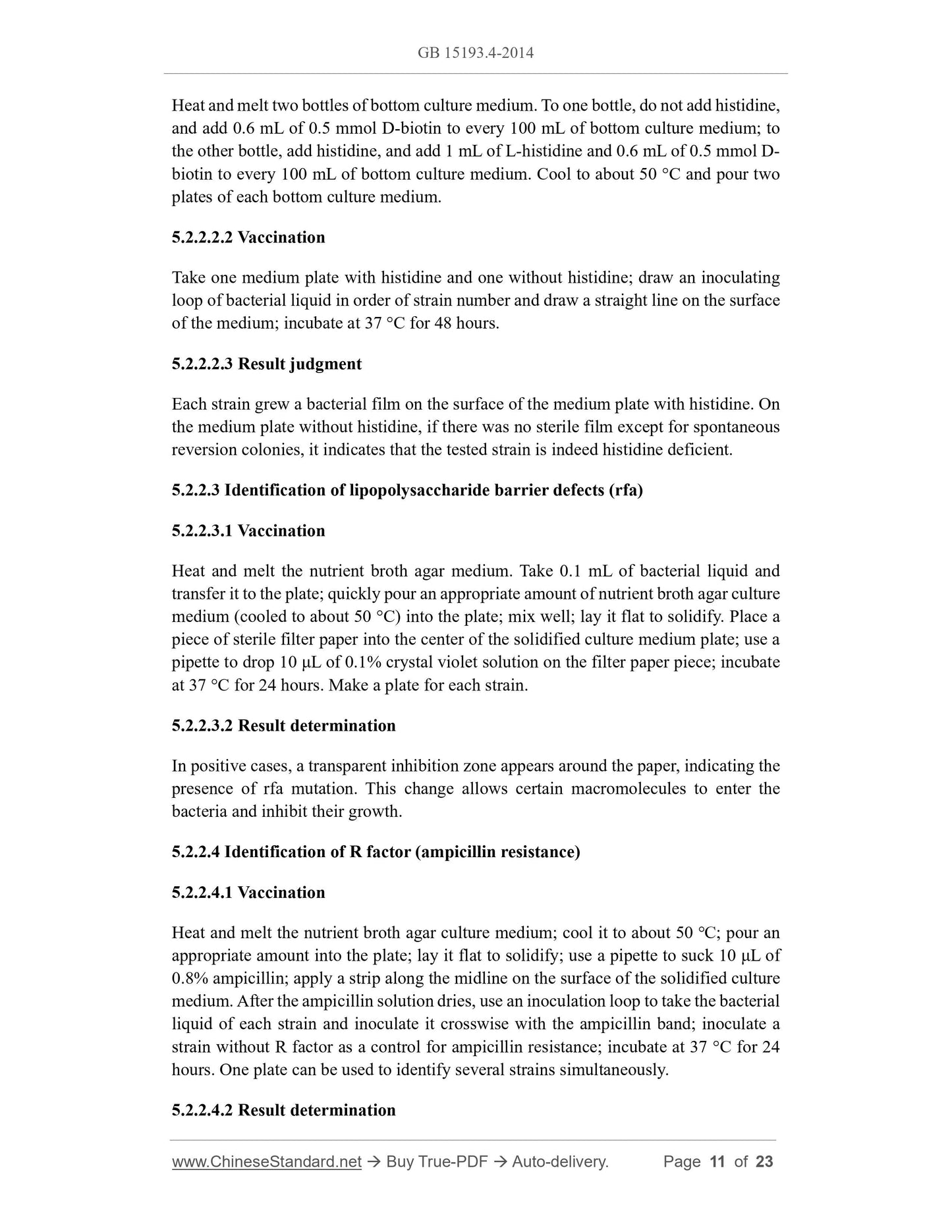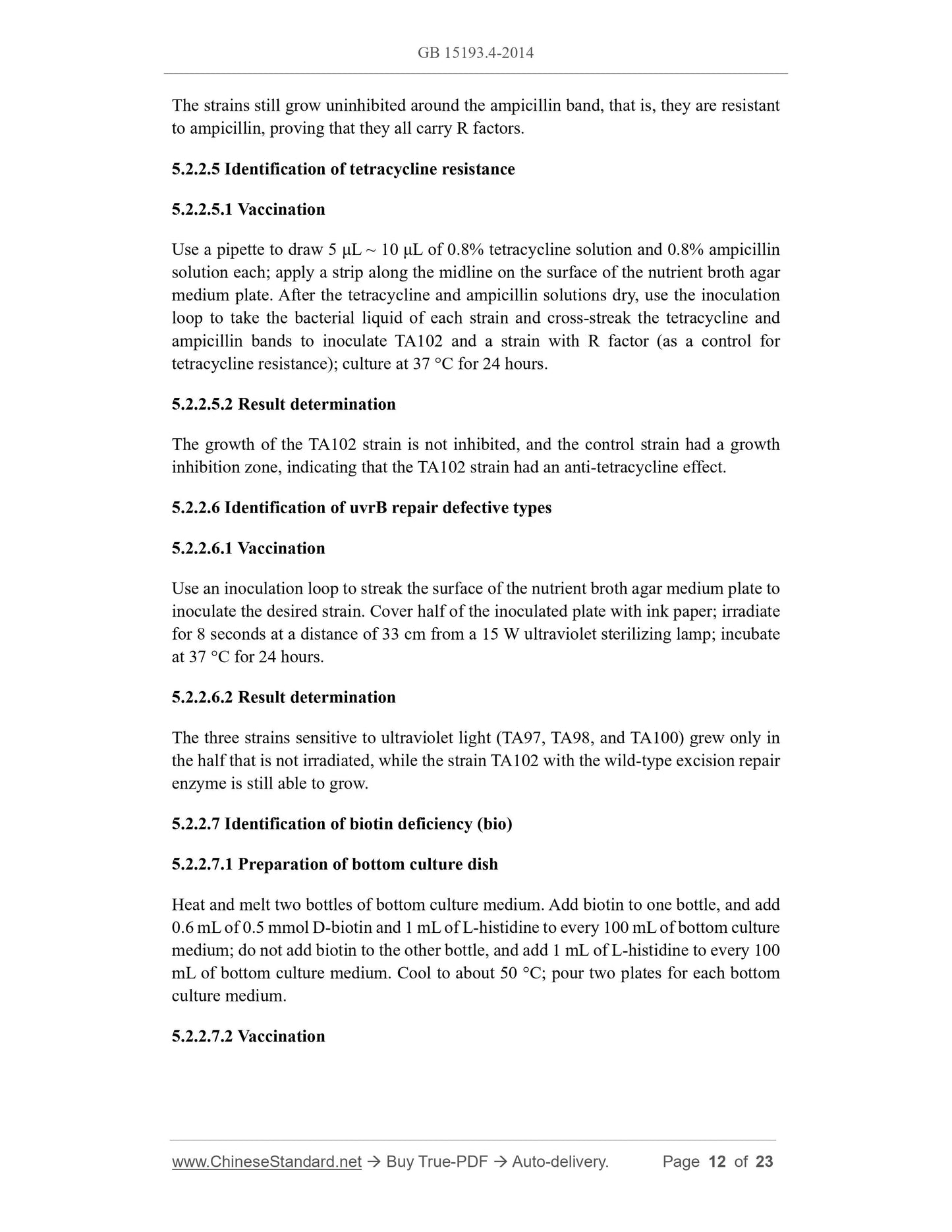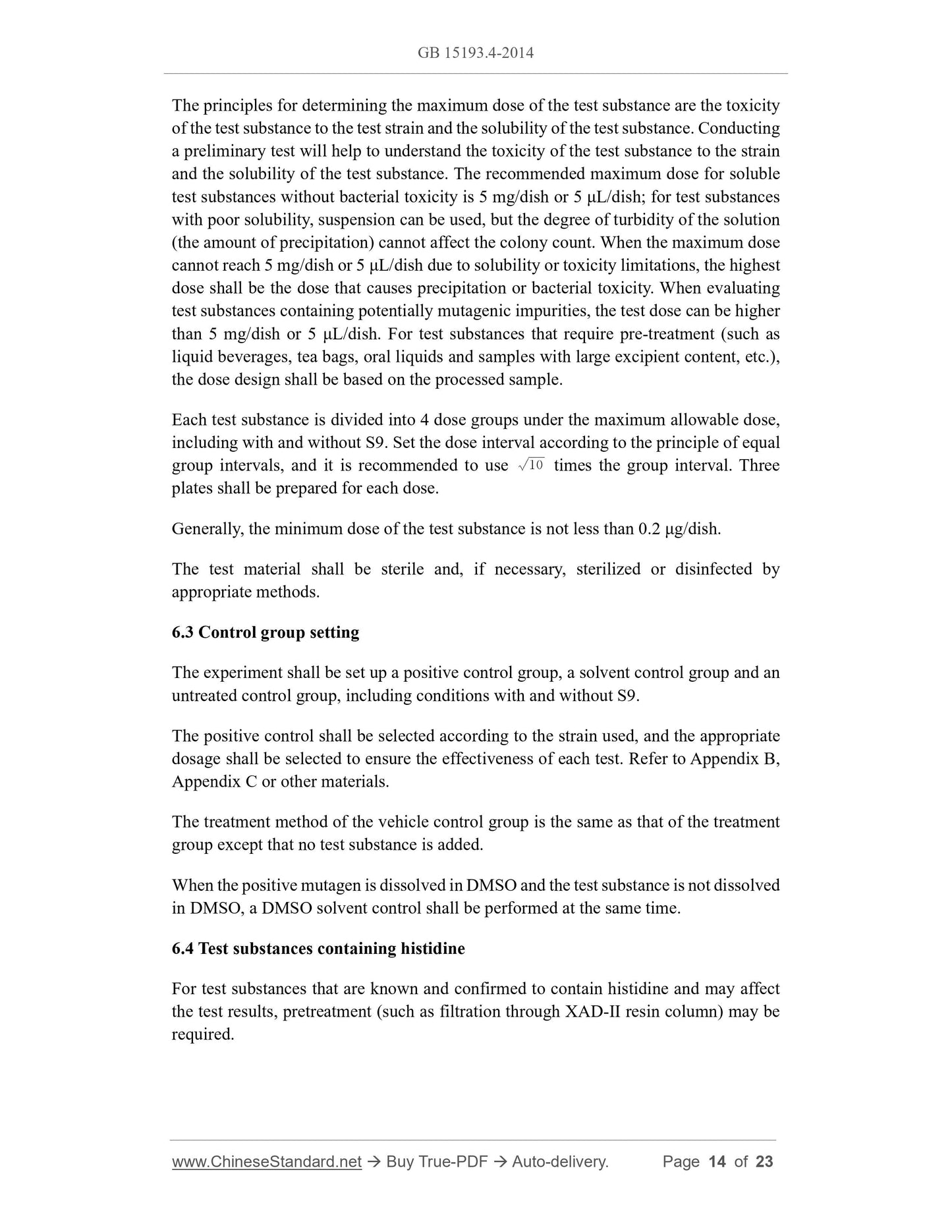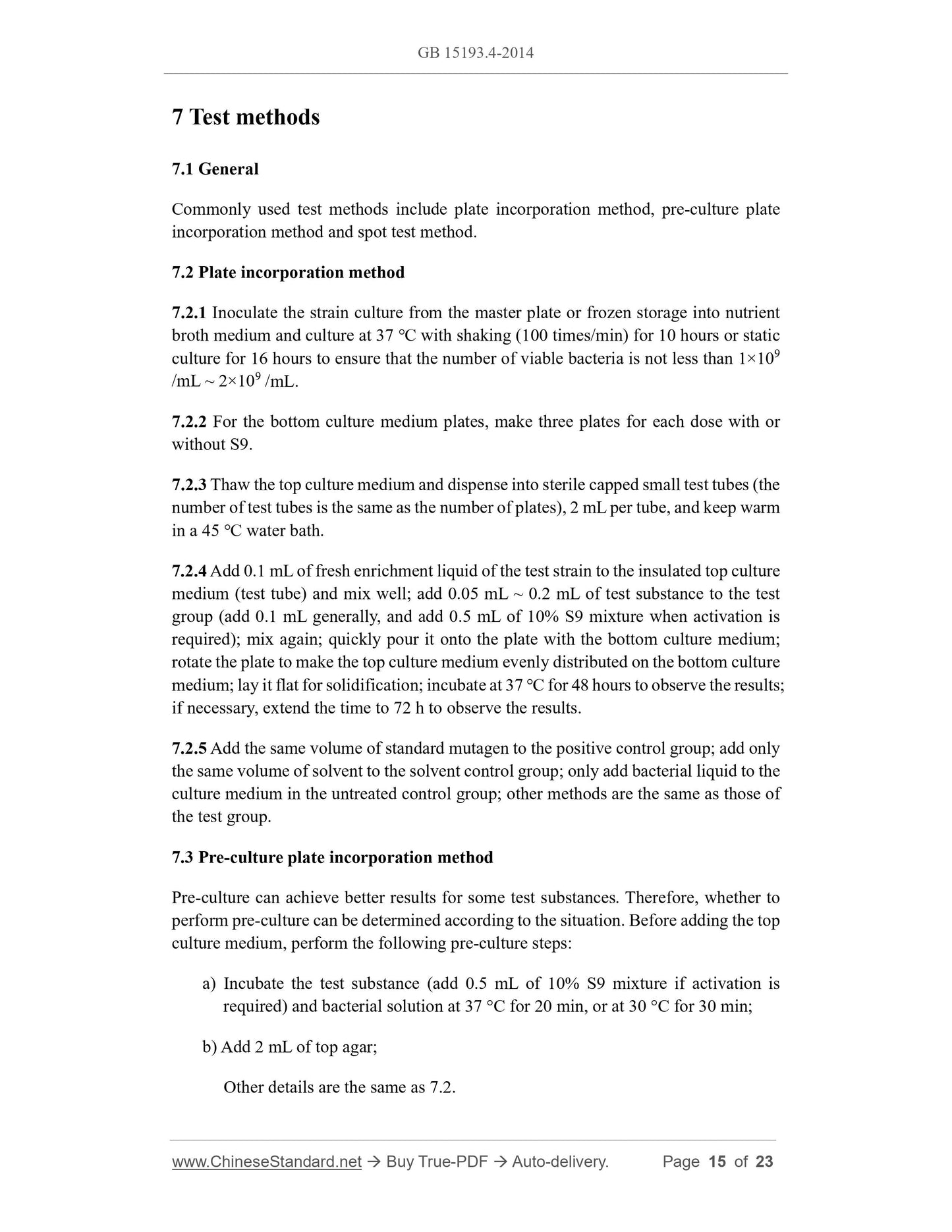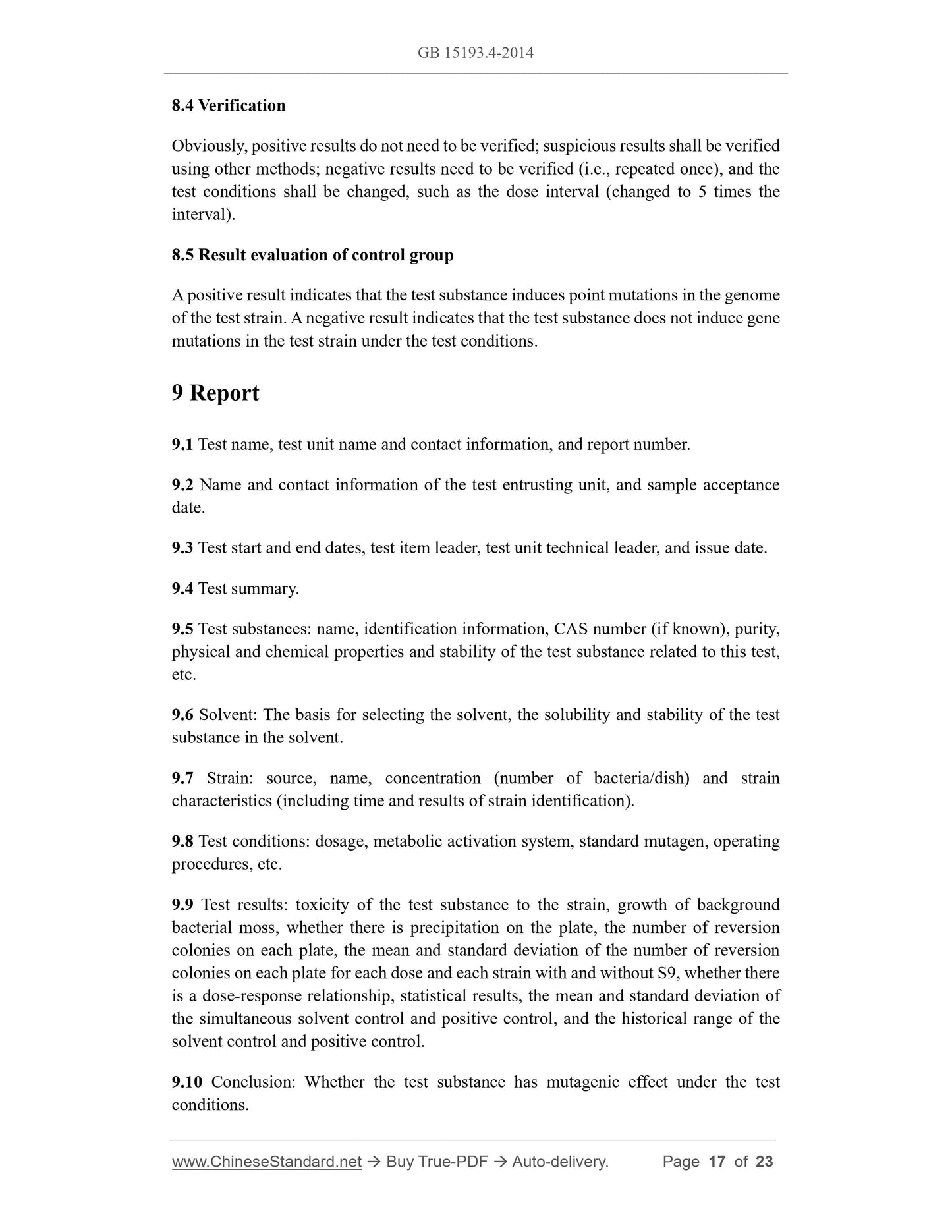1
/
of
11
PayPal, credit cards. Download editable-PDF and invoice in 1 second!
GB 15193.4-2014 English PDF (GB15193.4-2014)
GB 15193.4-2014 English PDF (GB15193.4-2014)
Regular price
$245.00 USD
Regular price
Sale price
$245.00 USD
Unit price
/
per
Shipping calculated at checkout.
Couldn't load pickup availability
Delivery: 3 seconds. Download true-PDF + Invoice.
Get QUOTATION in 1-minute: Click GB 15193.4-2014
Historical versions: GB 15193.4-2014
Preview True-PDF (Reload/Scroll if blank)
GB 15193.4-2014: National food safety standard -- Bacterial reversion mutation test
GB 15193.4-2014
GB
NATIONAL STANDARD OF THE
PEOPLE’S REPUBLIC OF CHINA
National food safety standard - Bacterial reversion mutation
test
ISSUED ON: DECEMBER 24, 2014
IMPLEMENTED ON: MAY 01, 2015
Issued by: National Health and Family Planning Commission of the People’s
Republic of China
Table of Contents
Foreword ... 3
1 Scope ... 4
2 Terms and definitions ... 4
3 Test purpose and principle ... 4
4 Apparatus and reagents ... 5
5 Bacterial strains and their identification and preservation ... 10
6 Design of experiments and treatment of test substances ... 13
7 Test methods ... 15
8 Data processing and result evaluation ... 16
9 Report ... 17
10 Interpretation of the test ... 18
Appendix A Mutant genes, test types, biological characteristics and spontaneous
reversion of test strains ... 19
Appendix B Standard diagnostic mutagens ... 21
Appendix C Positive mutagens recommended by OECD and USEPA ... 23
National food safety standard -
Bacterial reversion mutation test
1 Scope
Bacterial reverse mutation test includes Salmonella typhimurium reversion mutation
test and Escherichia coli reversion mutation test. This Standard specifies the basic
technical requirements for Salmonella typhimurium reversion mutation test. When
selecting Escherichia coli for bacterial reversion mutation test, relevant literature shall
be referred to.
This Standard is applicable to the evaluation of the mutagenic effect of test substances.
2 Terms and definitions
2.1 Bacterial reversion mutation test
An in vitro test for detecting gene mutations using auxotrophic mutant strains as
indicator organisms. Commonly used strains include histidine auxotroph Salmonella
typhimurium and tryptophan auxotroph Escherichia coli.
2.2 Base substitution gene mutation
A certain base on the DNA polynucleotide chain is replaced by another base, causing
abnormalities in the DNA base sequence.
2.3 Frameshift gene mutation
When one or several bases (except 3 and multiples of 3) are inserted or deleted in the
DNA base sequence, according to the rules of continuous reading of the triplet code, all
the codon composition after this site will be changed, and the polypeptide chain that
guides the synthesis will also be completely changed.
3 Test purpose and principle
Detect the genetic mutation effect of the test substance on microorganisms (bacteria)
and predict its genotoxicity and potential carcinogenic effects.
The bacterial reversion mutation test uses Salmonella typhimurium and Escherichia coli
to detect point mutations, involving the replacement, insertion or deletion of one or
several base pairs of DNA, as shown in Appendix A. The test strains of Salmonella
typhimurium and Escherichia coli are histidine-deficient mutants and tryptophan-
80 ℃, prepare plates at a rate of 25 mL per plate (relative to a 90 mm plate). After
condensation and solidification, place the plates upside down in a 37 ℃ incubator for
24 h for use.
4.2.3.2 Phosphate stock solution (Vogel-Bonner minimal medium E, 50 times)
Sodium ammonium hydrogen phosphate (NaNH4HPO4·4H2O) 17.5 g
Citric acid (C6H8O7·H2O) 10.0 g
Dipotassium hydrogen phosphate (K2HPO4) 50.0 g
Magnesium sulfate (MgSO4·7H2O) 1.0 g
Add distilled water to 100 mL to dissolve, and sterilize at 0.103 MPa for 20 minutes.
Note: After the other reagents are completely dissolved, slowly put the magnesium
sulfate into it to continue dissolving, otherwise it will easily precipitate.
4.2.3.3 40% glucose solution
Add distilled water to 40.0 g of glucose to 100 mL, and sterilize at 0.055 MPa for 20
minutes.
4.2.3.4 1.5% agar medium
Add 6.0 g of agar powder into a 400 mL conical flask; add distilled water to 400 mL;
after melting, sterilize at 0.103 MPa for 20 min.
4.2.4 Top culture medium
Heat to melt the top agar, add 10 mL of histidine-biotin solution (0.5 mmol/L) to every
100 mL of top agar. Mix well; divide into 4 flasks; sterilize at 0.103 MPa for 20 min.
Melt and divide into small test tubes, 2 mL per tube; keep warm in a 45 ℃ water bath.
Prepare top agar and histidine-biotin solution (0.5 mmol/L) as follows.
4.2.4.1 Top agar
Add distilled water to 3.0 g of agar powder and 2.5 g of sodium chloride to 500 mL;
sterilize at 0.103 MPa for 20 min.
4.2.4.2 Histidine-biotin solution (0.5 mmol/L) (for mutagenesis test)
Add 250 mL of distilled water to 30.5 mg of D-biotin (relative molecular mass 244)
and 19.4 mg of L-histidine (relative molecular mass 155); sterilize at 0.103 MPa for 20
min.
4.2.5 Special reagents and culture media
4.2.5.1 0.8% ampicillin solution (for strain identification, prepared aseptically)
Use sodium hydroxide solution (0.02 mol/L) to dilute 40 mg of ampicillin to 5 mL;
store it in a refrigerator at 4 °C for later use.
4.2.5.2 0.1% crystal violet solution (for strain identification)
Dissolve 100 mg of crystal violet in sterile water to 100 mL.
4.2.5.3 L-histidine solution and D-biotin solution (0.5 mmol/L) (for strain identification)
Respectively dissolve 0.404 3 g of L-histidine and 12.2 mg of D-biotin in distilled water
to 100 mL; sterilize at 0.103 MPa for 20 min; store in a 4 °C refrigerator for later use.
4.2.5.4 0.8% tetracycline solution (for tetracycline resistance test and ampicillin-
tetracycline plate)
Use hydrochloric acid buffer (0.02 mol/L) to dilute 40 mg of tetracycline to 5 mL; store
in a 4 °C refrigerator.
4.2.5.5 Ampicillin plate (used as the master plate for TA97, TA98, and TA100 strains)
and ampicillin-tetracycline plate (used as the master plate for TA102 strain)
Each 1 000 mL consists of the following ingredients:
Bottom culture medium 980 mL
Histidine aqueous solution (0.404 3 g/100 mL) 10 mL
Biotin (0.5 mmol/L) 6 mL
0.8% ampicillin solution 3.15 mL
0.8% tetracycline solution 0.25 mL
Tetracycline is added only when using tetracycline-resistant TA102. Each ingredient
has been individually sterilized or prepared aseptically.
4.2.5.6 Histidine-biotin plate (histidine needs to be used for testing)
Each 1 000 mL consists of the following ingredients:
Bottom culture medium 984 mL
Histidine aqueous solution (0.404 3 g/100 mL) 10 mL
Biotin (0.5 mmol/L) 6 mL
Each ingredient has been sterilized individually.
oral gavage at a dose of 80 mg/kg for 3 consecutive days without fasting. Kill the
animals by decapitation after 16 h of fasting. Other operations are the same as PCB
induction.
After killing the animals, remove the liver, weigh, and continuously flush with fresh
ice-cold potassium chloride solution (0.15 mol/L) several times to remove hemoglobin
that inhibits microsomal enzyme activity. Add 3 mL of potassium chloride solution (0.1
mol/L) per gram of liver (wet weight); move it together with the beaker into an ice bath;
use sterile scissors to cut the liver into pieces; place in a glass homogenizer (less than 4
000 r/min, 1 min ~ 2 min) or tissue homogenizer (less than 20 000 r/min, 1 min) to
make liver homogenate. The above operations require attention to sterility and local
cold environment.
Centrifuge the prepared liver homogenate in a low-temperature (0 ℃ ~ 4 ℃) high-
speed centrifuge at 9 000g for 10 minutes. Aspirate the supernatant into the S9
component and distribute it into sterile freezing tubes or ampoules. Each ampoule is
about 2 ml. Quick freeze in liquid nitrogen or dry ice and then store at 80 °C.
After the S9 component is prepared, subject it to a sterility inspection and measure the
protein con...
Get QUOTATION in 1-minute: Click GB 15193.4-2014
Historical versions: GB 15193.4-2014
Preview True-PDF (Reload/Scroll if blank)
GB 15193.4-2014: National food safety standard -- Bacterial reversion mutation test
GB 15193.4-2014
GB
NATIONAL STANDARD OF THE
PEOPLE’S REPUBLIC OF CHINA
National food safety standard - Bacterial reversion mutation
test
ISSUED ON: DECEMBER 24, 2014
IMPLEMENTED ON: MAY 01, 2015
Issued by: National Health and Family Planning Commission of the People’s
Republic of China
Table of Contents
Foreword ... 3
1 Scope ... 4
2 Terms and definitions ... 4
3 Test purpose and principle ... 4
4 Apparatus and reagents ... 5
5 Bacterial strains and their identification and preservation ... 10
6 Design of experiments and treatment of test substances ... 13
7 Test methods ... 15
8 Data processing and result evaluation ... 16
9 Report ... 17
10 Interpretation of the test ... 18
Appendix A Mutant genes, test types, biological characteristics and spontaneous
reversion of test strains ... 19
Appendix B Standard diagnostic mutagens ... 21
Appendix C Positive mutagens recommended by OECD and USEPA ... 23
National food safety standard -
Bacterial reversion mutation test
1 Scope
Bacterial reverse mutation test includes Salmonella typhimurium reversion mutation
test and Escherichia coli reversion mutation test. This Standard specifies the basic
technical requirements for Salmonella typhimurium reversion mutation test. When
selecting Escherichia coli for bacterial reversion mutation test, relevant literature shall
be referred to.
This Standard is applicable to the evaluation of the mutagenic effect of test substances.
2 Terms and definitions
2.1 Bacterial reversion mutation test
An in vitro test for detecting gene mutations using auxotrophic mutant strains as
indicator organisms. Commonly used strains include histidine auxotroph Salmonella
typhimurium and tryptophan auxotroph Escherichia coli.
2.2 Base substitution gene mutation
A certain base on the DNA polynucleotide chain is replaced by another base, causing
abnormalities in the DNA base sequence.
2.3 Frameshift gene mutation
When one or several bases (except 3 and multiples of 3) are inserted or deleted in the
DNA base sequence, according to the rules of continuous reading of the triplet code, all
the codon composition after this site will be changed, and the polypeptide chain that
guides the synthesis will also be completely changed.
3 Test purpose and principle
Detect the genetic mutation effect of the test substance on microorganisms (bacteria)
and predict its genotoxicity and potential carcinogenic effects.
The bacterial reversion mutation test uses Salmonella typhimurium and Escherichia coli
to detect point mutations, involving the replacement, insertion or deletion of one or
several base pairs of DNA, as shown in Appendix A. The test strains of Salmonella
typhimurium and Escherichia coli are histidine-deficient mutants and tryptophan-
80 ℃, prepare plates at a rate of 25 mL per plate (relative to a 90 mm plate). After
condensation and solidification, place the plates upside down in a 37 ℃ incubator for
24 h for use.
4.2.3.2 Phosphate stock solution (Vogel-Bonner minimal medium E, 50 times)
Sodium ammonium hydrogen phosphate (NaNH4HPO4·4H2O) 17.5 g
Citric acid (C6H8O7·H2O) 10.0 g
Dipotassium hydrogen phosphate (K2HPO4) 50.0 g
Magnesium sulfate (MgSO4·7H2O) 1.0 g
Add distilled water to 100 mL to dissolve, and sterilize at 0.103 MPa for 20 minutes.
Note: After the other reagents are completely dissolved, slowly put the magnesium
sulfate into it to continue dissolving, otherwise it will easily precipitate.
4.2.3.3 40% glucose solution
Add distilled water to 40.0 g of glucose to 100 mL, and sterilize at 0.055 MPa for 20
minutes.
4.2.3.4 1.5% agar medium
Add 6.0 g of agar powder into a 400 mL conical flask; add distilled water to 400 mL;
after melting, sterilize at 0.103 MPa for 20 min.
4.2.4 Top culture medium
Heat to melt the top agar, add 10 mL of histidine-biotin solution (0.5 mmol/L) to every
100 mL of top agar. Mix well; divide into 4 flasks; sterilize at 0.103 MPa for 20 min.
Melt and divide into small test tubes, 2 mL per tube; keep warm in a 45 ℃ water bath.
Prepare top agar and histidine-biotin solution (0.5 mmol/L) as follows.
4.2.4.1 Top agar
Add distilled water to 3.0 g of agar powder and 2.5 g of sodium chloride to 500 mL;
sterilize at 0.103 MPa for 20 min.
4.2.4.2 Histidine-biotin solution (0.5 mmol/L) (for mutagenesis test)
Add 250 mL of distilled water to 30.5 mg of D-biotin (relative molecular mass 244)
and 19.4 mg of L-histidine (relative molecular mass 155); sterilize at 0.103 MPa for 20
min.
4.2.5 Special reagents and culture media
4.2.5.1 0.8% ampicillin solution (for strain identification, prepared aseptically)
Use sodium hydroxide solution (0.02 mol/L) to dilute 40 mg of ampicillin to 5 mL;
store it in a refrigerator at 4 °C for later use.
4.2.5.2 0.1% crystal violet solution (for strain identification)
Dissolve 100 mg of crystal violet in sterile water to 100 mL.
4.2.5.3 L-histidine solution and D-biotin solution (0.5 mmol/L) (for strain identification)
Respectively dissolve 0.404 3 g of L-histidine and 12.2 mg of D-biotin in distilled water
to 100 mL; sterilize at 0.103 MPa for 20 min; store in a 4 °C refrigerator for later use.
4.2.5.4 0.8% tetracycline solution (for tetracycline resistance test and ampicillin-
tetracycline plate)
Use hydrochloric acid buffer (0.02 mol/L) to dilute 40 mg of tetracycline to 5 mL; store
in a 4 °C refrigerator.
4.2.5.5 Ampicillin plate (used as the master plate for TA97, TA98, and TA100 strains)
and ampicillin-tetracycline plate (used as the master plate for TA102 strain)
Each 1 000 mL consists of the following ingredients:
Bottom culture medium 980 mL
Histidine aqueous solution (0.404 3 g/100 mL) 10 mL
Biotin (0.5 mmol/L) 6 mL
0.8% ampicillin solution 3.15 mL
0.8% tetracycline solution 0.25 mL
Tetracycline is added only when using tetracycline-resistant TA102. Each ingredient
has been individually sterilized or prepared aseptically.
4.2.5.6 Histidine-biotin plate (histidine needs to be used for testing)
Each 1 000 mL consists of the following ingredients:
Bottom culture medium 984 mL
Histidine aqueous solution (0.404 3 g/100 mL) 10 mL
Biotin (0.5 mmol/L) 6 mL
Each ingredient has been sterilized individually.
oral gavage at a dose of 80 mg/kg for 3 consecutive days without fasting. Kill the
animals by decapitation after 16 h of fasting. Other operations are the same as PCB
induction.
After killing the animals, remove the liver, weigh, and continuously flush with fresh
ice-cold potassium chloride solution (0.15 mol/L) several times to remove hemoglobin
that inhibits microsomal enzyme activity. Add 3 mL of potassium chloride solution (0.1
mol/L) per gram of liver (wet weight); move it together with the beaker into an ice bath;
use sterile scissors to cut the liver into pieces; place in a glass homogenizer (less than 4
000 r/min, 1 min ~ 2 min) or tissue homogenizer (less than 20 000 r/min, 1 min) to
make liver homogenate. The above operations require attention to sterility and local
cold environment.
Centrifuge the prepared liver homogenate in a low-temperature (0 ℃ ~ 4 ℃) high-
speed centrifuge at 9 000g for 10 minutes. Aspirate the supernatant into the S9
component and distribute it into sterile freezing tubes or ampoules. Each ampoule is
about 2 ml. Quick freeze in liquid nitrogen or dry ice and then store at 80 °C.
After the S9 component is prepared, subject it to a sterility inspection and measure the
protein con...
Share
